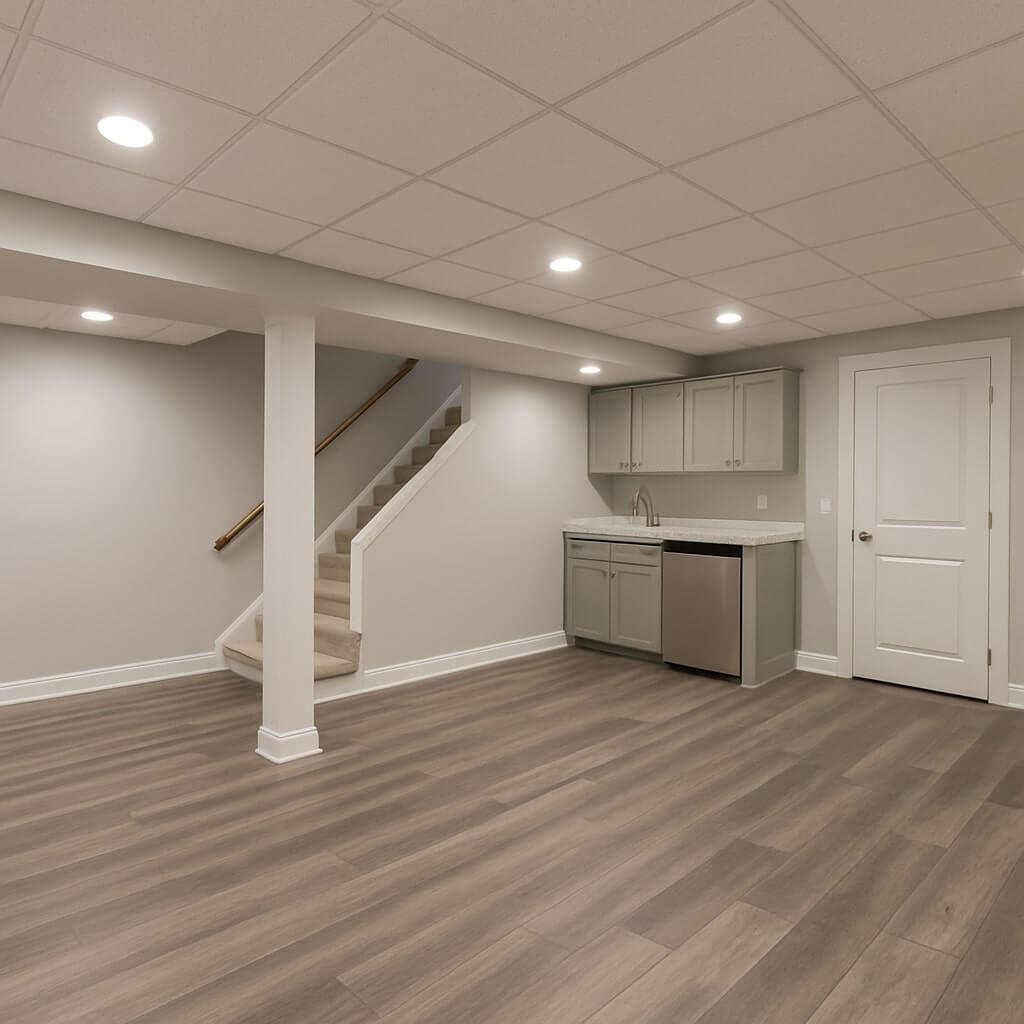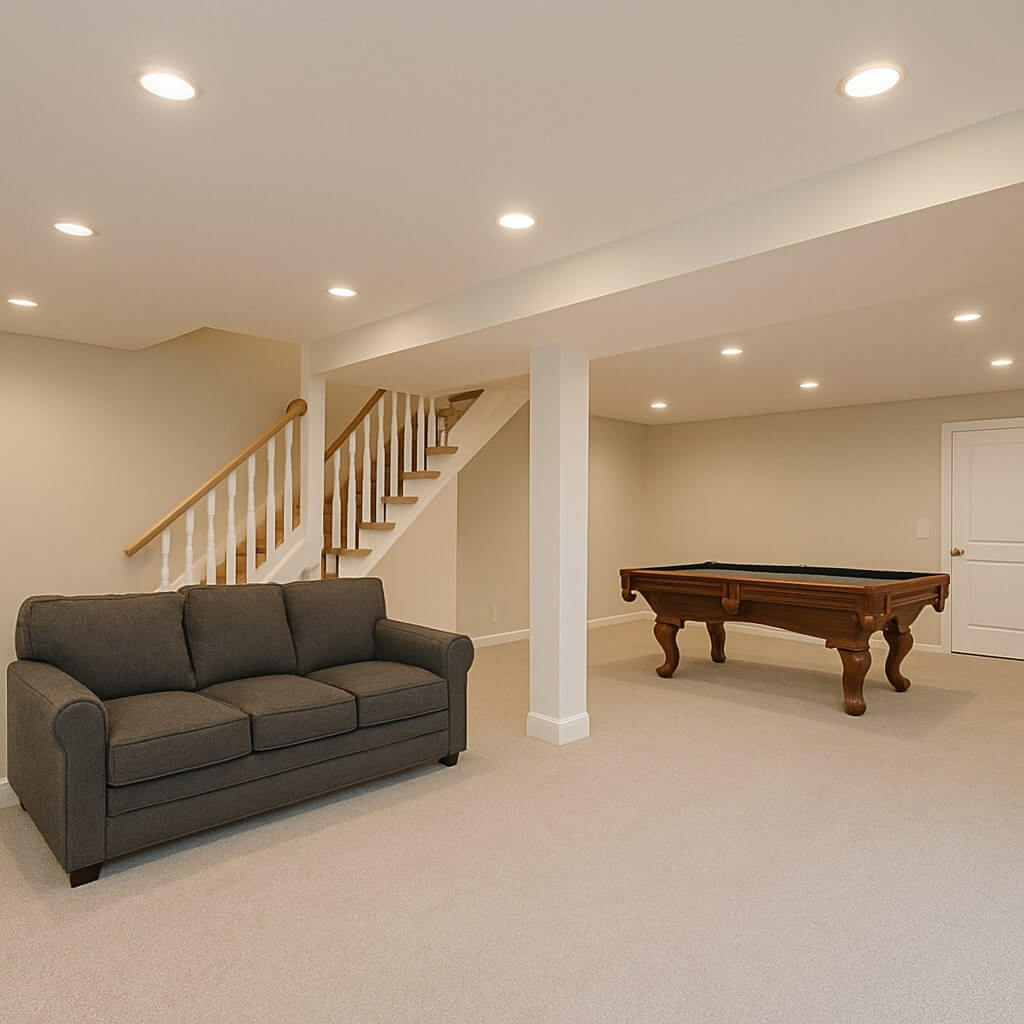When you’re considering remodeling your basement, it’s essential to understand the various factors that influence costs. From the size of your space to the specific purpose you envision, each element plays an important role in your budget. You’ll also need to think about design complexity and necessary permits. Knowing what to expect can help you make informed decisions, but there’s more to uncover that could greatly impact your project’s outcome.
Key Takeaways
- The size of the basement influences design options, budget, and material choices needed for the remodel.
- Existing conditions, such as water damage or ceiling height, impact safety and usability, affecting overall renovation costs.
- The intended purpose of the space determines layout, lighting, and storage requirements, influencing design complexity and expenses.
- Permits and local regulations can add costs and delays; understanding these is essential for compliant remodeling.
- Labor costs vary based on project complexity, geographic location, and availability of skilled workers, affecting total remodeling expenses.
Size of the Basement

When it comes to remodeling a basement, the size of the space is an essential factor that can greatly influence your design options and overall functionality.
Understanding your basement dimensions helps you determine how to best utilize the available area. If you’ve got a larger space, consider creating distinct zones for activities like entertainment, storage, or a home office.
In smaller basements, maximizing space utilization is key—think built-in furniture or multi-functional areas.
Existing Conditions
Before diving into your basement remodeling project, it’s essential to assess the existing conditions of the space. A thorough existing conditions assessment helps identify potential issues, while a structural integrity evaluation guarantees safety. Check for water damage, mold, or cracks in the foundation, as these can impact your remodel.
| Aspect | Importance |
|---|---|
| Water Damage | Can lead to mold growth |
| Mold Presence | Affects air quality and safety |
| Foundation Cracks | Indicates structural issues |
| Ceiling Height | Impacts usability and design |
Understanding these factors will guide your remodeling decisions effectively.
Purpose of the Space
Defining the purpose of your basement space is essential for a successful remodeling project, as it shapes design choices and functionality.
Consider your finished purpose: do you want a cozy family room, a home office, or even a guest suite? Your intended use will guide decisions about layout, lighting, and storage solutions.
Determining your basement’s purpose—be it a family room, office, or guest suite—will influence key design choices.
For instance, a playroom requires different features than a workout area. By clarifying the purpose upfront, you’ll guarantee the final result meets your needs and enhances your home’s value.
Take the time to envision how you’ll use the space, and your remodeling investment will pay off in satisfaction and practicality.
Design Complexity
As you immerse yourself in the remodeling process, understanding design complexity is essential for ensuring your basement meets your expectations.
Consider the current design trends and how they align with your aesthetic choices. A more intricate design often involves custom features, unique layouts, and layered lighting, which can elevate your space but also increase costs.
Simplifying your design can help stay within budget while still achieving a stylish look. Prioritize your must-haves, and don’t hesitate to consult professionals who can guide you through the complexities, ensuring your vision transforms into a functional and beautiful basement retreat.
Permits and Regulations

Maneuvering through permits and regulations is essential for a successful basement remodel, especially since failing to comply can lead to costly delays and fines.
Understanding permit types and their regulation impact will keep your project on track. Here’s what you need to reflect on:
- Building permits for structural changes
- Electrical permits for wiring updates
- Plumbing permits for any water-related work
- Egress window permits for safety compliance
- Zoning regulations to guarantee your remodel aligns with local codes
Stay informed and consult local authorities to streamline your remodeling process and avoid headaches later on.
Flooring Options
When choosing flooring for your basement, you’ll want to evaluate material costs, installation complexity, and how durable the flooring will be over time.
Each option has its pros and cons, affecting both your budget and the maintenance you’ll need to keep up with.
Let’s explore these factors to find the perfect flooring for your space.
Material Cost Considerations
Choosing the right flooring for your basement remodel can greatly impact both the aesthetic and budget of your project.
When evaluating material types, it’s crucial to weigh the costs against your design goals. Here are some popular options to think about:
- Vinyl: Affordable and water-resistant.
- Carpet: Cozy but may require more maintenance.
- Laminate: Budget-friendly with a wood-like appearance.
- Tile: Durable and stylish, but can be pricier.
- Concrete: Modern and versatile, often the lowest cost.
Installation Complexity Levels
While the aesthetic appeal of your basement flooring is important, understanding the installation complexity can save you time and money. Different materials come with varying installation challenges.
For example, luxury vinyl planks are easier to install than tile or hardwood, making them a smart choice if you’re looking for a DIY project. Consider renovation strategies that match your skill level and time constraints.
If you choose more complex flooring, hiring a professional may be wise. Weighing these factors not only influences your budget but also guarantees the final result meets your expectations and fits your lifestyle.
Durability and Maintenance Needs
Selecting the right flooring for your basement isn’t just about looks; it’s crucial to take into account durability and maintenance needs.
Choosing the right durability materials can save you time and money in the long run. Consider these options:
- Vinyl: Water-resistant and easy to clean.
- Tile: Durable and perfect for moisture control.
- Carpet: Cozy but requires regular maintenance schedules.
- Laminate: Affordable and scratch-resistant.
- Concrete: Long-lasting but may need sealing.
Electrical and Plumbing Needs

When remodeling your basement, you’ll need to take into account the electrical wiring and plumbing layout carefully.
Upgrading your electrical system guarantees you have enough power for lighting and appliances, while adjusting plumbing can enhance functionality and accessibility.
Let’s explore what you need to know to get these vital systems right.
Wiring Requirements
As you plan your basement remodel, understanding the wiring requirements for electrical and plumbing needs is crucial for creating a safe and functional space.
Prioritizing wiring safety and energy efficiency will save you time and money. Here are key considerations:
- Verify all wiring meets local codes.
- Use energy-efficient fixtures and appliances.
- Plan for adequate outlets and circuits.
- Consider dedicated circuits for high-demand appliances.
- Install GFCI outlets in wet areas.
Plumbing Layout Adjustments
Once you’ve tackled the wiring requirements, it’s time to contemplate how plumbing layout adjustments can enhance your basement remodel. Properly positioning plumbing fixtures not only boosts layout efficiency but also improves functionality. Consider how each fixture—sinks, toilets, or showers—works within the space.
| Fixture Type | Ideal Location | Impact on Layout Efficiency |
|---|---|---|
| Sink | Near kitchen | Enhances workflow |
| Toilet | Private area | Maximizes privacy |
| Shower | Corner space | Optimizes room use |
| Washer/Dryer | Utility nook | Streamlines laundry tasks |
| Bar Sink | Entertainment zone | Fosters social interaction |
Make informed decisions, and your basement will shine!
Insulation and Ventilation
Effective insulation and ventilation are essential for transforming your basement into a comfortable living space.
Effective insulation and ventilation are crucial for creating a cozy and inviting basement environment.
To guarantee ideal comfort, consider the following:
- Insulation types: fiberglass batts, foam boards, spray foam, cellulose, and reflective barriers
- Ventilation systems: exhaust fans, dehumidifiers, air exchangers, window vents, and HVAC systems
- Moisture control: use vapor barriers to prevent dampness
- Temperature regulation: maintain consistent temperatures with proper insulation
- Air quality: guarantee fresh air circulation to eliminate musty odors
Lighting Choices
Creating a welcoming atmosphere in your basement goes beyond insulation and ventilation; lighting plays a pivotal role in defining the space. You’ll want to balance ambient lighting, which sets the mood, with task lighting, essential for specific activities. Consider using adjustable fixtures for versatility.
| Lighting Type | Purpose | Examples |
|---|---|---|
| Ambient | General illumination | Ceiling fixtures |
| Task | Focused activities | Desk lamps, sconces |
| Accent | Highlight features | Spotlights, LED strips |
Choose wisely, and your basement will transform into a functional and inviting area.
Labor Costs
When remodeling your basement, understanding labor costs is essential for budgeting effectively.
Skilled labor rates can vary considerably based on project complexity and your geographic location, impacting the overall expense.
Knowing these factors helps you plan ahead and make informed decisions for your renovation.
Skilled Labor Rates
Skilled labor rates play an essential role in the overall cost of remodeling a basement. Understanding these rates can help you budget effectively.
Here are some factors to take into account:
- Experience level: More experienced workers often command higher rates.
- Type of skilled trades: Electricians, plumbers, and carpenters may have varying costs.
- Location: Rates differ based on regional demand and cost of living.
- Labor unions: Unionized workers might charge more due to negotiated wages.
- Project scope: Larger projects may require specialized skills, affecting rates.
Being informed will help you navigate costs and make the best decisions for your remodel.
Project Complexity Impact
The complexity of your basement remodeling project directly influences labor costs. A larger project scope typically requires more skilled labor, which can increase your overall expenses. Additionally, the renovation timeline may extend if your project involves structural changes or intricate designs.
Here’s a quick overview of how project complexity can affect costs:
| Complexity Level | Labor Cost Impact |
|---|---|
| Simple Updates | Lower Costs |
| Moderate Changes | Moderate Costs |
| Structural Work | Higher Costs |
| Custom Designs | Highest Costs |
Understanding these factors helps you budget more effectively for your basement remodel.
Geographic Location Variance

While labor costs for basement remodeling can vary significantly, your geographic location plays an essential role in determining those expenses.
Factors influencing costs include:
- Climate considerations: Extreme weather may require specialized labor.
- Regional pricing: Urban areas often have higher labor rates.
- Local demand: High demand for remodeling can drive up costs.
- Availability of skilled labor: Some regions may face shortages, increasing rates.
- Permitting and regulations: Different areas have varying requirements that can affect labor costs.
Understanding these elements helps you budget effectively for your basement remodel, ensuring you get the best value for your investment.
Conclusion
When planning your basement remodel, keep these factors in mind to guarantee you stay within budget and achieve your desired outcome. The size, existing conditions, and purpose of the space all play vital roles, along with design complexity and necessary permits. Don’t forget about electrical, plumbing, insulation, and lighting choices, as they can add to your costs. By understanding these elements, you can make informed decisions and create a basement that perfectly suits your needs.




